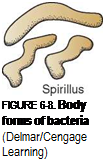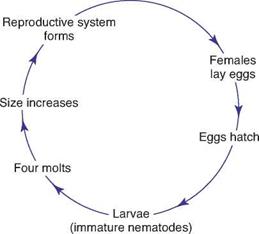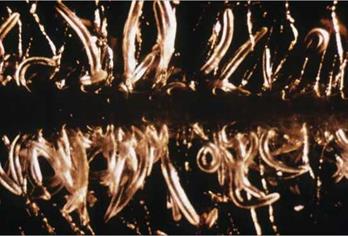While many plant pathologists include the injuries induced by abiotic causes in their broadest consideration of plant disease, what will be explained here are the biotic, parasitic causal agents. Each type of injurious agent is a parasite, incapable of producing its own food and relying upon a host plant to provide its nourishment.
The most important causes of disease in plants are the bacteria, fungi, viruses, and nematodes. Also important, but of less significance in terms of the sheer number of diseases they create, are the viroids and



 mollicutes. All are microscopic in size, reproduce prolifically, and have a remarkable ability to survive. Following is a summary of the important characteristics of the pathogen groups.
mollicutes. All are microscopic in size, reproduce prolifically, and have a remarkable ability to survive. Following is a summary of the important characteristics of the pathogen groups.
Bacteria
a. Members of the Kingdom Protista
b. Nonchlorophyllous
c. Single-celled prokaryotes
d. Three body forms: spherical (coccus), rod-shaped (bacillus), and spiral-shaped (spirillus) (Figure 6-8). Only the bacillus form causes plant diseases.
e. Reproduction by simple cell division.
f. Some forms survive unfavorable conditions as hard-coated spores termed endospores.
g. Some forms propel themselves by means of whip-like appendages termed flagella. Bacteria may have a single flagellum at one end (monotrichous), more than one flagellum at one end (lophotric – hous), or flagella all over the cell (peritrichous) (Figure 6-9).
h. All pathogenic species of bacteria are classified within six genera:
1. Pseudomonas
2. Xanthomonas
3. Erwinia
4. Corynebacterium
5. Agrobacterium
6. Streptomyces
 |
Monotrichous Flagellum
figure 6-9. Flagellation forms of bacteria (Delmar/Cengage Learning)
Mollicutes
a. Smaller in size than most bacteria.
b. The smallest, free-living, self-replicating forms of life
c. Nonchlorophyllous prokaryotes
d. Lack a cell wall
e. Lack the flagella of bacteria. They move by gliding and twisting.
f. Classified in the Kingdom Protista; two types are known:
1. Phytoplasmas
2. Spiroplasmas
Fungi
a. Members of the Kingdom Fungi
b. Nonchlorophyllous, nonmotile eukaryotes
c. Their vegetative body (called a thallus) ranges in size from a single cell to a thread-like multicellular structure termed a mycelium. The individual threadlike filaments making up the mycelium are hyphae. The functions of the hyphae are to absorb nutrients from the host plant, reproduce the fungus by formation of sexual and asexual fruiting structures, and survive adverse conditions (Figure 6-10).
d. Reproduction by formation of spores
e. Classification is on the basis of life cycle, specifically how the vegetative and reproductive organs develop
f. Fungi are placed in five classes by most mycologists:
1. Chytridiomycetes
2. Zygomycetes
3. Ascomycetes
4. Basidiomycetes
5. Deuteromycetes
A number of nuclear changes occur during the life cycle of the fungi (Figure 6-11). Fungi that reproduce sexually have haploid nuclei (containing half the normal number of chromosomes) during the vegetative (gametophytic) stage. The sexual cells (gametes) form during the haploid phase. The fusion of two compatible gametes occurs during plasmogamy, marking the beginning of the diploid phase (which brings together two sets of matching chromosomes). When the two sexual nuclei actually fuse, the stage of caryogamy is achieved. The result of the fertilization is a zygote. The zygote eventually becomes the organ in which reduction and division (meiosis) occurs. Following meiosis, haploid spores are formed which germinate to form the vegetative thallus. During the gametophytic stage, additional spores may be produced asexually. These are termed conidia (singular conidiospore). Each conidiospore is capable of germinating and forming a new thallus. With many pathogenic fungi, the number of asexual conidia produced far surpasses the number of sexual spores produced, making them the most significant pathogenic form.
 |
|
|
|


Acervulus
• shallow and saucer-shaped
• conidia are produced on the surface after host cells rupture
Pycnidium
• hard walled
• sac-like shape
• conidia are produced within
Sporodochium
• ruptures the host epidermis
• conidia form atop a mound of hyphae


 |
 |
Sexual fruiting bodies
figure 6-ю. Fruiting bodies common to many of the fungal pathogens (Delmar/Cengage Learning)
Haploid spores germinate
Nematodes
a. Members of the animal kingdom
b. Feed on both plants and animals. Nearly a thousand species attack plant parts. Those that complete most of their life cycle within a host plant are termed endoparasitic. Those whose life cycle occurs outside the host plant are ectoparasitic.
c. Plant nematodes average about 1 millimeter in length.
d. Body wall usually transparent, with an outer covering termed a cuticle
e. Feeding apparatus consists of mouthparts equipped with a buccal spear used to puncture the host cell to withdraw cellular fluids.
f. Favored by light, sandy soils with a high average temperature
g. Life cycle generally simple. The females lay eggs that hatch to form larvae. These larvae grow and pass through a series of four molts, finally reaching the adult stage (Figures 6-12A and 6-12B).
Slugs and Snails
a. Members of the animal kingdom
b. Macroscopic in size
c. Nocturnal feeders on plant leaves and stems
d. Slugs lack the shell that is common to snails
e. Leave a slimy trail on the soil surface as they move
Parasitic Seed Plants
a. Weakly chlorophyllous but usually incapable of meeting their own nutritional needs
b. Connect to the vascular tissue of chlorophyllous higher plants
c. Varying levels of parasitism



figure 6-12A. General life cycle of a plant nematode (Delmar/Cengage Learning)
figure 6-12B. Nematodes feeding on a plant root (Courtesy USDA)
• Epiphytic: make their own food but need structural support such as Spanish Moss
• Semiparasitic: make their own food using water and nutrients absorbed from the host plant such as mistletoe, Indian warrior
• Fully parasitic: incapable of photosynthesizing and totally dependent on the host plant for all nutritional needs such as dodder



